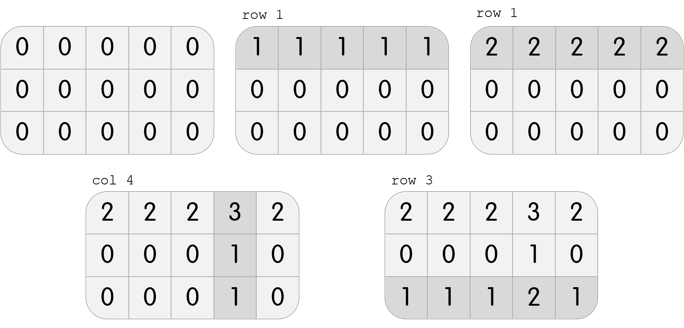Codeforces Round #419 (Div. 2) C. Karen and Game
On the way to school, Karen became fixated on the puzzle game on her phone!

The game is played as follows. In each level, you have a grid with n rows and m columns. Each cell originally contains the number 0.
One move consists of choosing one row or column, and adding 1 to all of the cells in that row or column.
To win the level, after all the moves, the number in the cell at the i-th row and j-th column should be equal to gi, j.
Karen is stuck on one level, and wants to know a way to beat this level using the minimum number of moves. Please, help her with this task!
The first line of input contains two integers, n and m (1 ≤ n, m ≤ 100), the number of rows and the number of columns in the grid, respectively.
The next n lines each contain m integers. In particular, the j-th integer in the i-th of these rows contains gi, j (0 ≤ gi, j ≤ 500).
If there is an error and it is actually not possible to beat the level, output a single integer -1.
Otherwise, on the first line, output a single integer k, the minimum number of moves necessary to beat the level.
The next k lines should each contain one of the following, describing the moves in the order they must be done:
- row x, (1 ≤ x ≤ n) describing a move of the form "choose the x-th row".
- col x, (1 ≤ x ≤ m) describing a move of the form "choose the x-th column".
If there are multiple optimal solutions, output any one of them.
3 5
2 2 2 3 2
0 0 0 1 0
1 1 1 2 1
4
row 1
row 1
col 4
row 3
3 3
0 0 0
0 1 0
0 0 0
-1
3 3
1 1 1
1 1 1
1 1 1
3
row 1
row 2
row 3
In the first test case, Karen has a grid with 3 rows and 5 columns. She can perform the following 4 moves to beat the level:

In the second test case, Karen has a grid with 3 rows and 3 columns. It is clear that it is impossible to beat the level; performing any move will create three 1s on the grid, but it is required to only have one 1 in the center.
In the third test case, Karen has a grid with 3 rows and 3 columns. She can perform the following 3 moves to beat the level:

Note that this is not the only solution; another solution, among others, is col 1, col 2, col 3.
题意:
给定n行m列数字,每次可以让一行或一列都减一,求出让全部数字全为0的最小的次数,没有则输出-1;
思路:
就是对行和列处理,注意下n和m的大小就行。
第一次比赛打了三道。。。上了一波大分。
#include <bits/stdc++.h> using namespace std; const int N = 200; int n, m, a[N][N], c[N], r[N], ans; int check() { for (int i = 0; i < n; i++) for (int j = 0; j < m; j++) if (a[i][j]) return 0; return 1; } void row_man() { for (int i = 0; i < n; i++) { int mi = a[i][0]; for (int j = 1; j < m; j++) mi = min(mi, a[i][j]); r[i] = mi; ans += r[i]; for (int j = 0; j < m; j++) a[i][j] -= mi; } } void col_man() { for (int j = 0; j < m; j++) { int mi = a[0][j]; for (int i = 1; i < n; i++) mi = min(mi, a[i][j]); c[j] = mi; ans += c[j]; for (int i = 0; i < n; i++) a[i][j] -= mi; } } int main() { cin >> n >> m; for (int i = 0; i < n; i++) for (int j = 0; j < m; j++) scanf("%d", &a[i][j]); if (n > m) { col_man(); row_man(); } else { row_man(); col_man(); } if (!check()) puts("-1"); else { cout << ans << endl; for (int i = 0; i < n; i++) for (int j = 0; j < r[i]; j++) printf("row %d\n", i + 1); for (int i = 0; i < m; i++) for (int j = 0; j < c[i]; j++) printf("col %d\n", i + 1); } }




 浙公网安备 33010602011771号
浙公网安备 33010602011771号